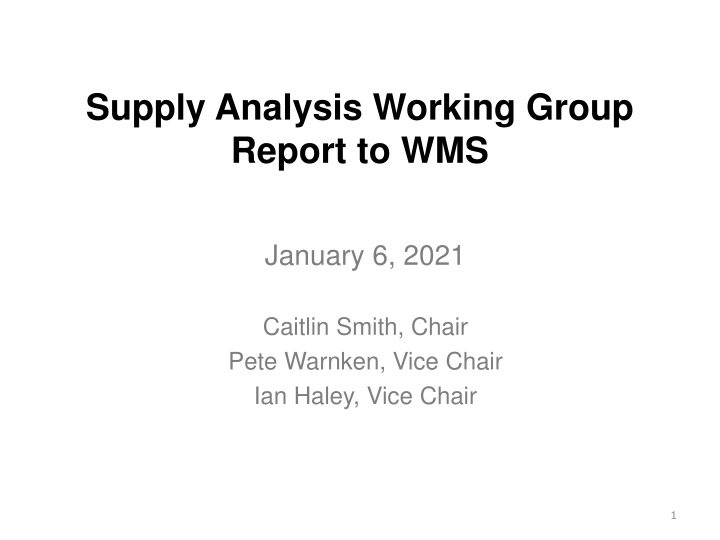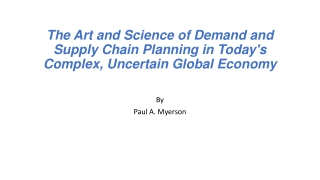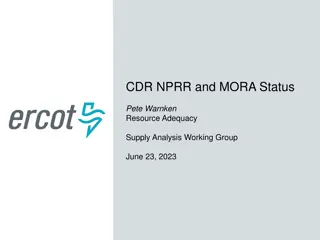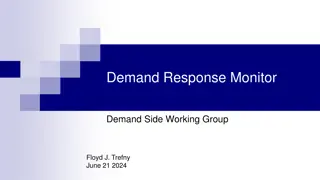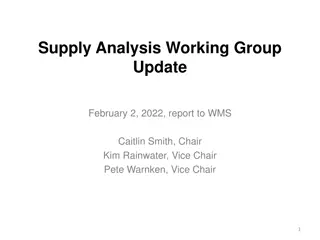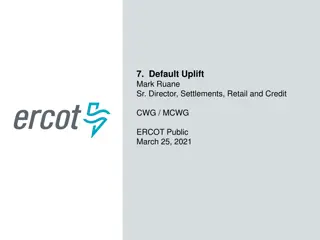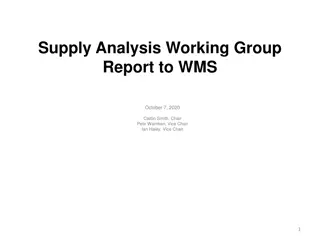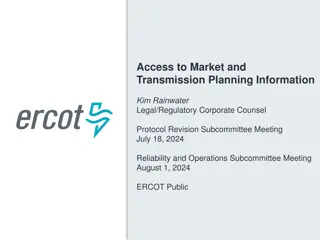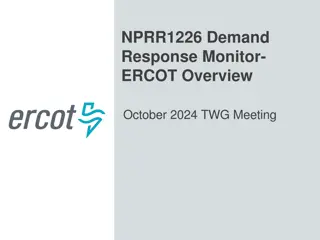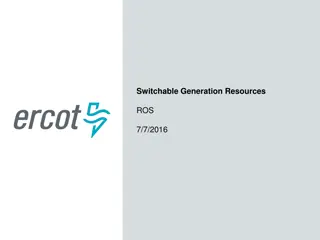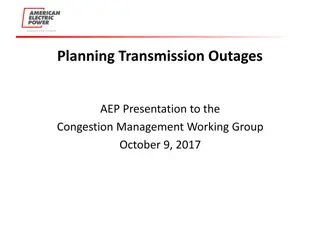ERCOT Supply Analysis Report Overview
The report provides insights on the 2020 Reserve Margin Study in ERCOT, covering topics such as optimal reserve margin estimates, market equilibrium, impacts of wind and solar penetration, and future steps. It also includes a summary of the Planning Reserve Margin forecast for summer 2021 and beyond. Stay informed about the changing landscape of resource adequacy in ERCOT through this comprehensive analysis.
Download Presentation

Please find below an Image/Link to download the presentation.
The content on the website is provided AS IS for your information and personal use only. It may not be sold, licensed, or shared on other websites without obtaining consent from the author.If you encounter any issues during the download, it is possible that the publisher has removed the file from their server.
You are allowed to download the files provided on this website for personal or commercial use, subject to the condition that they are used lawfully. All files are the property of their respective owners.
The content on the website is provided AS IS for your information and personal use only. It may not be sold, licensed, or shared on other websites without obtaining consent from the author.
E N D
Presentation Transcript
Supply Analysis Working Group Report to WMS January 6, 2021 Caitlin Smith, Chair Pete Warnken, Vice Chair Ian Haley, Vice Chair 1
2020 Reserve Margin Study Background: In 2014 the PUCT asked Brattle and Astrap to estimate the economically-optimal reserve margin in ERCOT to inform their review of market design for resource adequacy EORM/MERM study updated every two years starting in mid-2018 Impacts & 2020 Results: 2020 study quantifies the 2024 values for: Economically Optimal Reserve Margin - EORM 11% Market Equilibrium Reserve Margin - MERM (in energy-only equilibrium) 12.25% As evaluated every two years, the study can show the changing values of EORM and MERM to show changes in resource adequacy in ERCOT Major changes to 2020 study from 2018: Increased wind and solar penetration Updated methodology for modeling PRD ORDC Changes Reference technologies 2
2020 Reserve Margin Study Final Draft Report released 12/1 30-day comment period for stakeholder comment December SAWG Q&A topics: Comparison of EORM shape from 2018 Study to 2020 Study CT production cost savings in 2020 Study vs CC savings in 2018 Study System cost asymmetry around MERM Impact of forced outage rates on MERM Battery duration assumptions Impact of co-optimization of energy and ancillary services Renewable resource accounting Next Steps: RM Report Question Comments document will be updated with further questions http://www.ercot.com/calendar/2020/12/18/195774-SAWG Requests for more data from the Astrap report go to Pete Warnken Pete.Warnken@ercot.com & ERCOT will return to SAWG with a summary on requests and plan for if/how much data will be provided to stakeholders Astrap to come back after comment period and report finalized 3
December CDR Summary The planning reserve margin for summer 2021 is forecasted to be 15.5%, down 1.8% from the May CDR. Between 2022 and 2025, the planning reserve margin is expected to reach as high as 27%. 4
December CDR Summary Capacity: Decrease May CDR was due to solar and wind project delays and cancellations Note: SAWG will continue GINR analysis in February with the topics: summer 2020 planned projects success review and revisiting project COD delays, GINR trends in delays and cancellations Demand: CDR incorporates demand served by Lubbock Power and Light beginning in June 2021 The forecasted peak demand for summer 2021 is 77,244 MW used revised economic data released by Moody s Analytics in August. this is a decrease in expected peak demand from the May CDR Rooftop Solar: Note: due to continued and accelerated growth in rooftop solar projects, ERCOT included its first, separate rooftop solar PV forecast in the CDR. The forecast was created to show the incremental capacity growth beyond the historical growth trend reflected in the load forecast. The Rooftop Solar Scenarios Tab is separate from the information on residential rooftop solar in the summary and uses an s-curve approach 5
December CDR Summary Waterfall chart showing itemized changes in the reserve margins reported in the 2020 May/December CDRs 6
December Long-Term Load Forecast Rooftop PV Forecast A forecast was created for residential ESIIDs using the load profile assignment for each weather zone Total installed capacity was approximately 700 MW as of August 2020 Forecast is for the total installed capacity to increase to approximately 2,100 MW by August 2030 The assumed capacity factor at the time of the summer peak is 46% Rooftop PV Forecast Notes: Residential ESIIDs with PV have greater average usage per hour than ESIIDs without PV during the early morning and evening hours Some studies suggest that customers with PV tend to use more energy To compensate for this, should the shapes be unitized? Note that the Rooftop Solar Scenarios Tab on CDR uses s-curve More analysis to follow at SAWG and by ERCOT 9
December Long-Term Load Forecast Load Forecast Adjustments Lubbock added to North Forecast from 2021 Rayburn added to East Forecast from 2021 Adjustments added for Large Industrial Facilities Coast: 425 650 MW phased in over time South: 75 930 MW phased in over time South Central: 24 480 MW phased in over time Next steps: Long-term Load Forecast methodology and data files to be posted to ercot.com with market notice by end of this week 10
Net Load Forecast Update ERCOT will return to SAWG with, and continue to work on, options for methods regarding the capacity contributions for wind and solar Probable options: Use existing CDR capacity contributions Use net load capacity contributions Use probabilistic assumptions 11
SAWG Leadership 2021 Propose keeping same leadership: Chair Caitlin Smith, AB Power Advisors Vice Chair Ian Haley, Vistra Vice Chair Pete Warnken, ERCOT 12
SAWG Upcoming 2021 Questions/Requests: Requests for more data from the Astrap report go to Pete Warnken Pete.Warnken@ercot.com & ERCOT will return to SAWG with a summary on requests and plan for if/how much data will be provided to stakeholders Questions on December CDR & Long Term Load Forecast Questions on CDR to Pete Pete.Warnken@ercot.com Questions on Long Term Load Forecast to Calvin Opheim Calvin.Opheim@ercot.com Q&A to go to SAWG listserv and possibly be presented at February 5th SAWG Long-term Load Forecast methodology and data files to be posted to ercot.com with market notice by end of this week Upcoming 2021 topics: Battery energy storage capacity contribution Probabilistic SARA Net Load Forecast Regions for Solar Capacity Contribution CDR GINR Analysis on project delays Next SAWG meeting February 5th 13
